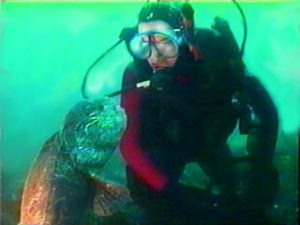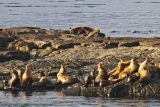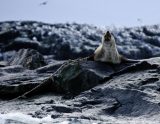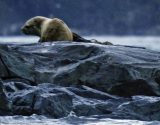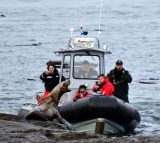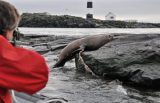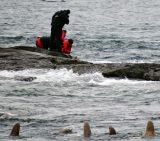Anarrhichthys ocellatus
-
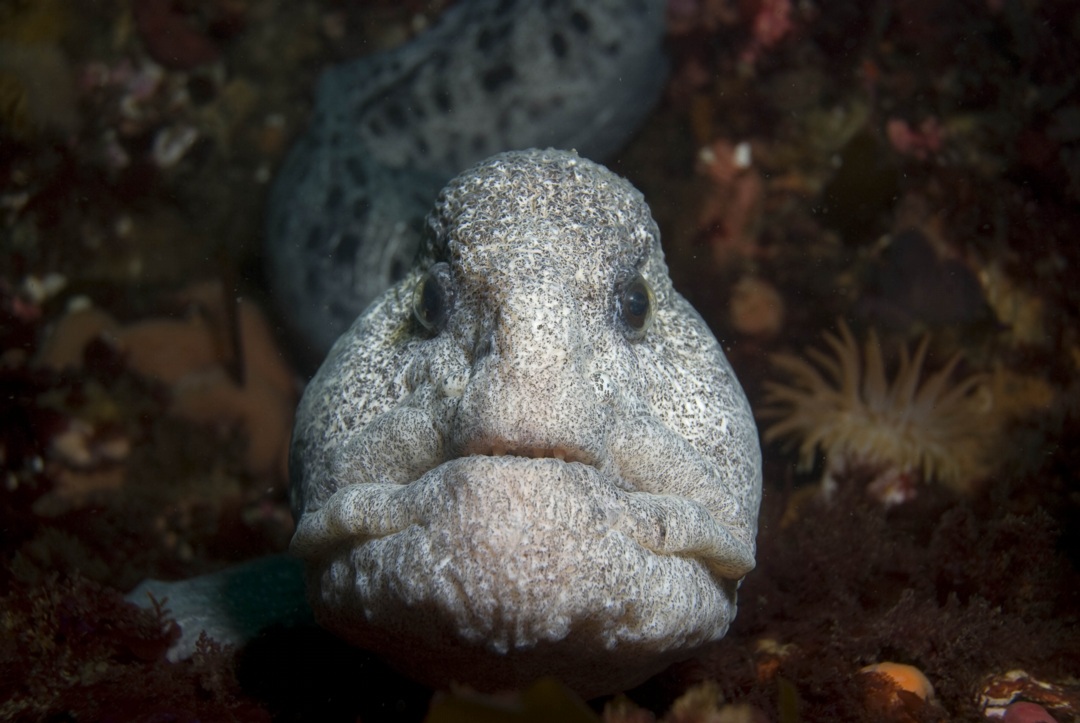
-
This Wolf eel has taken up residence somewhere in the vicinity of the tidal current energy piling. August, 2008 photos by Erik Schauff (copyright)
-
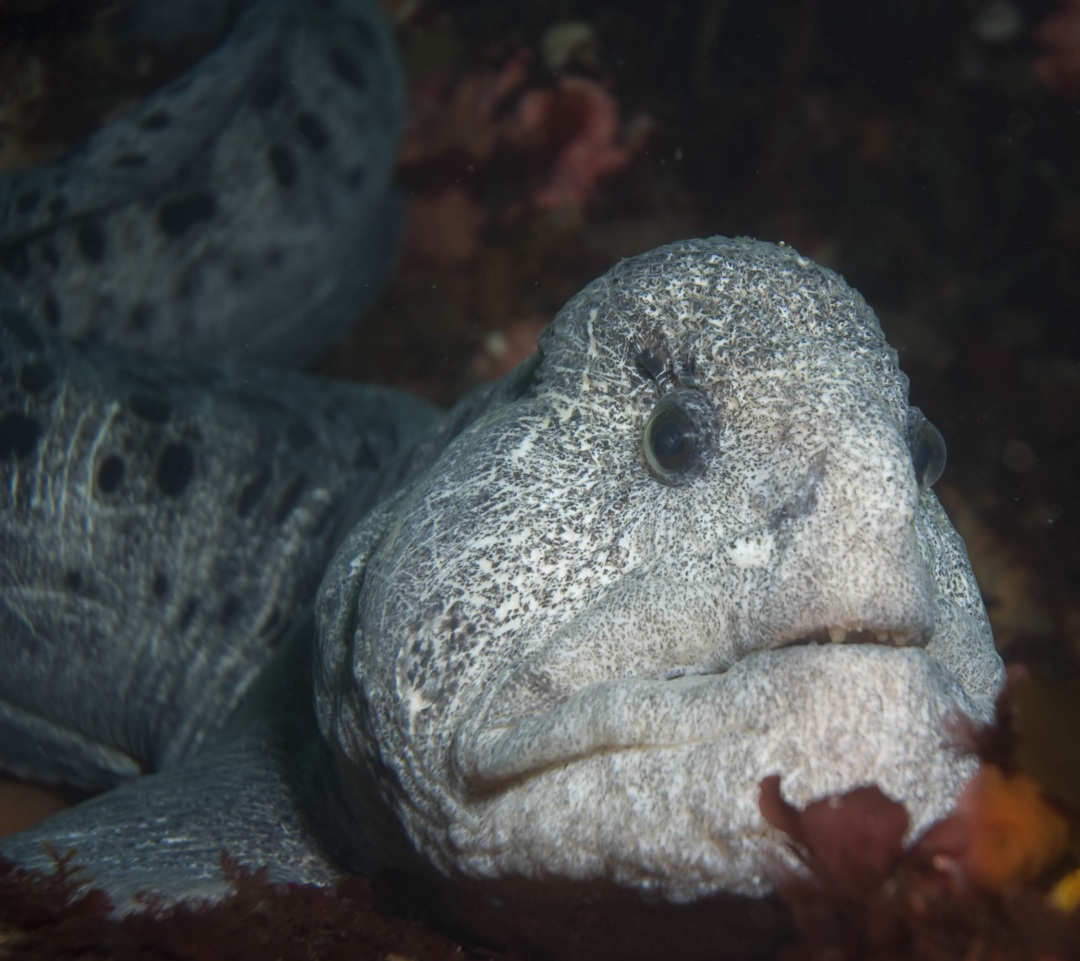
Description: Although the behaviors of the wolf eel are relatively limited at this moment, they still deem to be one of the most interesting species found in the waters. Its name originates from the greek word Anarhichas-– a fish in which the wolf eel resembles– and the latin word ocellatus which means eye-like spots. In general, Wolf-eels are easily to identify. There name suggests that they resemble eel like structures which range in colour from grey to brown or green. Starting from a young age, their coloration starts with a burnt orange spotted look graduallty changing into a dominant grey for males and brown for females. The males and females both have a dorsal fin that stretches from head to the end of their body. On average, a Wolf-eel is seen to possess a body of 2 meters long and characterized by a unique pattern of spots that appear to be individualized both in males and in females. In addition, the Wolf-eel possesses a large square head coupled with powerful jaws and canine teeth allowing for easier mastication– a beneficial adaptation to its environment of hard-shelled animals.
Classification:
Domain Eukarya
Kingdom Animalia
Phylum Chordata
Class Actinopterygii
SuperOrder Acanthoptergygii
Order Perciformes
SubOrder Zoarcoide
Family Anarhichadidae
Genus Anarrhichthys
Species ocellatus
Common Name: Wolf-eel
Habitat and Range: Wolf-eels can most abundantly be found from the sea of Japan and the Aleutian islands continuing southwards to imperial beach, Southern California. Wolf-eels live from barely subtidal waters to 740 feet (Love, 1996). The island of Racerocks is one of the sites in the Pacific Northwest in which the Wolf-eel can be found. Exploring the island, the most common places would be near the Rosedale reef and along the cliff near the docks. The rocky reefs and stony bottom shelves at shallow and moderate depths serve to be the abodes of the Wolf-eel. They will usually stake out a territory in a crevice, den or lair in the rocks. In addition, the Wolf-eel possesses a long, slender body which allows them to squeeze into their rocky homes. During the juveniles years of the Wolf-eel, they can most commonly be found in the upper part of the water, residing there for about two years. As the Wolf-eel ages, it will slowly migrate to the ocean floor and maintain an active lifestyle. Eventually, the Wolf-eel will find a rock shelter and “vegetate” for the remainder of its lifespan.
Diet: The adaptation of the Wolf-eel’s jaw to crush hard objects, as mentioned, deems to be beneficial for eating other organisms around its environment. The gourment delicacies that the Wolf-eel feeds upon are crustaceans, sea urchins, mussels, clams, snails some other fishes.
Mating and Other Interesting Facts: In aquaria, males and females form pairs at about 4 years of age and produce eggs at 7 years old. Spawning usually occurs from October into late winter. A male will butt his head against the female’s abdomen then wrap himself around her as a sign for a mating call. It has been found that the male fertilizes the eggs as they are laid and up to 10 000 eggs can be released at a single time. The father and mother will then wrap themselves around the egg masses and will guard the eggs for about 13-16 weeks when the eggs will then hatch. Possible predators that prey on the eggs include Benthic rockfishes and kelp greenlings. This process will continue periodically and repetitively for the lifespan of a Wolf-eel as it has been found that Wolf-eel’s mate for life.
Conservation Notes: At the moment, many fishers use rockhopper trawls to fish rough, rocky sea floors. This method causes the destruction of the rocky reefs in which the Wolf-eel resides. At the current moment, scientists are calling for a halt in the use of rockhopper trawls and an alternative method of using longline traps which don’t harm the rocky reefs.
References: Love, Milton, Probably more than you want to know about the fishes of the Pacific Coast: A humorous guide to Pacific fishes, California, Really Big Press, 1996, pg. 298
Lamb, Andy and Edgell, Phil, Coastal Fishes of the Pacific Northwest, BC Canada, Harbour Publishing, 1986, pg. 94.
Other members of the Class Actinopterygii at Race Rocks.



